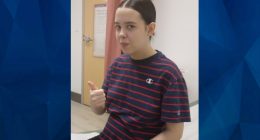Students across New South Wales will be walking into a new age of learning today following the rollout of the ‘explicit’ teaching model state-wide.
The model calls for teachers to show students ‘exactly how to do something step by step’ and have them practise over and over until they get it right, instead of letting them ‘find their own way’.
And, according to Dr Jenny Donavan, the CEO of the Australian Education Research Association, it is the best way to ensure students don’t emerge from studies with critical gaps in knowledge.
The former teacher says it also works ‘for everyone’ unlike the newly ousted ‘inquiry’ method, which sees children from more privileged backgrounds continue to outrank and outperform their peers.
‘The first thing explicit teaching does is check to see what the students already know, then it builds on that baseline so no one falls behind,’ she said.
It does not rely on parents filling in the gaps at home, which often lead to kids from poorer or less-educated areas failing.
Despite being used across classrooms in countries known for academic success – such as Singapore – the method isn’t welcomed by everyone.
In fact, it has left teachers rolling their eyes and declaring another fad, older generations screaming about education ‘going backwards’ and parents utterly confused.

Dr Jenny Donavan the CEO of the Australian Education Research Association, pictured, explained why she’s a fan of the explicit teaching model
‘Nothing is “new” in the education system, everything is just re-branded,’ one teacher fumed at news explicit teaching was coming in.
He added that teachers are often thrown into subjects they aren’t trained in – due to shortages – and have ‘classes of 30’ to cater for leaving every kid with less than 90 seconds of one-on-one time per 50-minute lesson.
‘Explicit instruction is very challenging in mixed ability classes,’ he roared.
According to a NSW Education Department Spokesperson, explicit teaching has had a place in the classroom for years but teachers just haven’t been told to focus on it as their core method.
‘It is already used regularly in most NSW public primary and secondary schools, across many different subjects,’ they told FEMAIL ahead of the official roll-out.
‘Explicit teaching does not discriminate. So, if you are a student who is struggling, or accelerating beyond your class level, explicit teaching will help you reach your potential.’
On social media many have been busily debating the pros and cons of the method.
Many claimed explicit teaching was just a hyped-up version of ‘old-school’ learning, which was slowly replaced by inquiry-based study 30 years ago.
‘Here we go, the same merry-go-round us teachers are supposed to smile and agree when most of the older ones have been doing this in the classroom since the beginning,’ one person, supposedly a teacher, claimed online.

Teachers were ‘taught’ how to use the new method in school during the pupil-free day at the beginning of term two
While another said: ‘This was the method previously applied, before the standards began falling. It was taught universally by teacher training colleges. Incrementally from about the mid-1960s a new American fad was applied , that was child centred immersion and osmosis as the best teaching method. We are now where that method was always going to take us.’
But Dr Donavan told Daily Mail Australia people who are likening the teaching method to those practiced in the past aren’t understanding it – especially those claiming older teachers were taught explicit teaching in college.
‘People describe it as old fashioned. When I went to university to study teaching in the 80s I got taught children are natural learners – which wasn’t helpful,’ she said.
In fact, Dr Donavan said explicit teaching will have a huge impact on learning outcomes as well as classroom behaviour.
They will be taught step-by-step what is expected and how to do ‘it’ and they will follow it up with lots of practice.
The state-wide rollout means the method will be more effective as teachers will have a uniform approach to teaching and classroom management.
Dr Donavan says students won’t fall through the cracks with explicit teaching because ‘there are no cracks’.
However, she does admit it will take time to see results reflected in test scores.
This is because teachers need to practice what they have been taught about the teaching method which they did yesterday, on the pupil free day.
Parents have added to the furor claiming ‘good teachers’ are the answer to classroom problems and poor results – though Dr Donavan and the Departments both criticised that as simplistic.
Dr Donavan said most teachers across NSW are excellent educators – they just need systems in place to help.
‘Our education system should be helping our kids to become analytical and curious lifelong learners. Explicit teaching followed immediately by explicit testing may produce higher scores in the short term, but is useless in providing the skills and dispositions needed to prepare kids for living in the real world,’ one parent argued.
But Dr Donavan disagreed and told FEMAIL that the sturdy knowledge base and hands-on interactive approach of explicit teaching not only engages kids but gives them a solid base to build on in their own time, as problems arise in everyday life.
‘You can’t build knowledge on nothing but when presented with something novel you can draw on that information to come up with your own ideas,’ she said.





